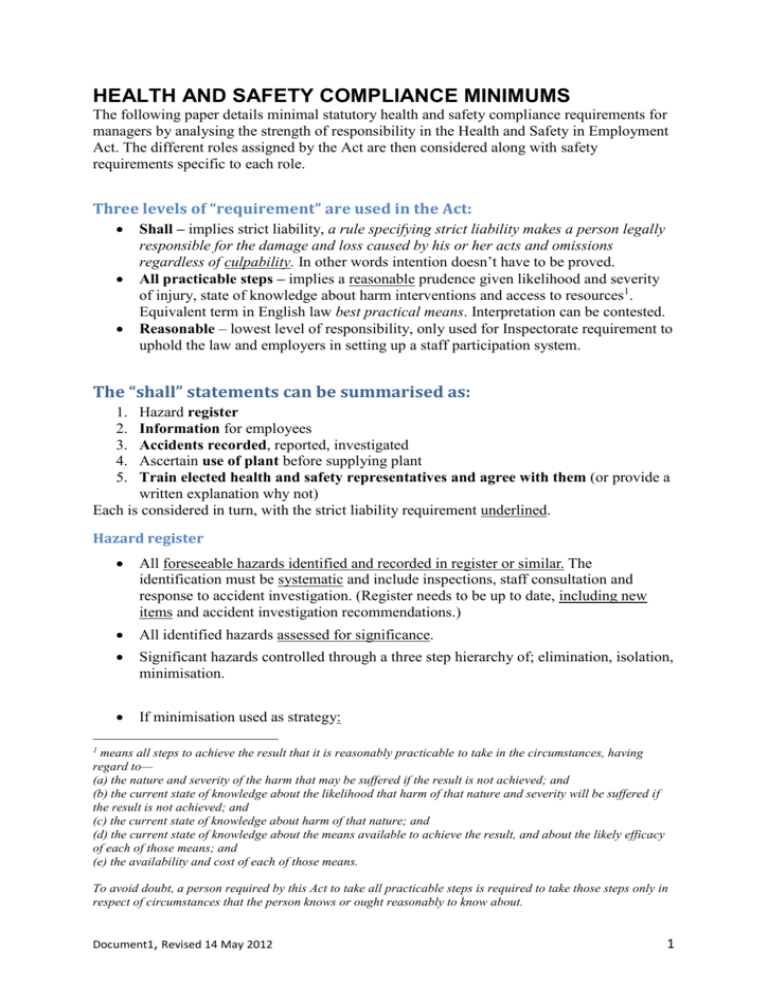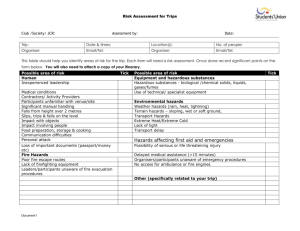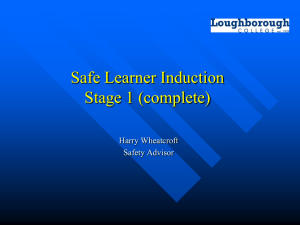Compliance minimums and roles
advertisement

HEALTH AND SAFETY COMPLIANCE MINIMUMS The following paper details minimal statutory health and safety compliance requirements for managers by analysing the strength of responsibility in the Health and Safety in Employment Act. The different roles assigned by the Act are then considered along with safety requirements specific to each role. Three levels of “requirement” are used in the Act: Shall – implies strict liability, a rule specifying strict liability makes a person legally responsible for the damage and loss caused by his or her acts and omissions regardless of culpability. In other words intention doesn’t have to be proved. All practicable steps – implies a reasonable prudence given likelihood and severity of injury, state of knowledge about harm interventions and access to resources1. Equivalent term in English law best practical means. Interpretation can be contested. Reasonable – lowest level of responsibility, only used for Inspectorate requirement to uphold the law and employers in setting up a staff participation system. The “shall” statements can be summarised as: 1. 2. 3. 4. 5. Hazard register Information for employees Accidents recorded, reported, investigated Ascertain use of plant before supplying plant Train elected health and safety representatives and agree with them (or provide a written explanation why not) Each is considered in turn, with the strict liability requirement underlined. Hazard register All foreseeable hazards identified and recorded in register or similar. The identification must be systematic and include inspections, staff consultation and response to accident investigation. (Register needs to be up to date, including new items and accident investigation recommendations.) All identified hazards assessed for significance. Significant hazards controlled through a three step hierarchy of; elimination, isolation, minimisation. If minimisation used as strategy: 1 means all steps to achieve the result that it is reasonably practicable to take in the circumstances, having regard to— (a) the nature and severity of the harm that may be suffered if the result is not achieved; and (b) the current state of knowledge about the likelihood that harm of that nature and severity will be suffered if the result is not achieved; and (c) the current state of knowledge about harm of that nature; and (d) the current state of knowledge about the means available to achieve the result, and about the likely efficacy of each of those means; and (e) the availability and cost of each of those means. To avoid doubt, a person required by this Act to take all practicable steps is required to take those steps only in respect of circumstances that the person knows or ought reasonably to know about. Document1, Revised 14 May 2012 1 a. Provide personal protective equipment and ensure it is used and b. Monitor exposure to significant hazards. (e.g. systems to report discomfort, concerns, incident accidents, staff satisfaction, performance review). Information requirements Employeesand elected Health and Safety representatives o Hazards and their controls o Emergency procedures. o The results of any monitoring. o The location of protective equipment. Elected Health and Safety representatives o Systems information provided o Safety issues information Recording accidents is not an optional activity Accidents recorded, reported, investigated All accidents recorded. Includes anyone in workplace – i.e. staff, contractors, students Serious harm notified to Department of Labour and accident scenes secured until clearance obtained. Investigations carried out to determine causes – record non-resolved to hazards in hazard register. Ascertain use of plant before supplying plant2 Applies if you hire plant, lease plant, or loan plant that can be used in place of work. Ask if it is to be used in place of work? If yes what is the intended use? Plant must be designed, made, and maintained so safe for indented use. Train elected health and safety representatives and agree with them (or provide written explanation why not) Must allow each elected representative 2 days paid leave to attend approved safety training If a safety committee or representative makes a health and safety recommendation it must be followed or written reasons why the proposal will not be implemented Role responsibility Another way to view the Act is to consider what functional roles might have a safety responsibility. More than one role can exist at any one time (they are not always mutually exclusive). 2 As an employer – usually means an employment contract Plant has a very broad meaning, "Plant" includes-- (a) Appliance, equipment, fitting, furniture, implement, machine, machinery, tool, and vehicle; and (b) Part of any plant, the controls of any plant, and anything connected to any plant: Document1, Revised 14 May 2012 2 As a principal - someone who arranges a services to be done for gain or reward (can be non monetary) – e.g. free accommodation for XXX, or clean this tree up and you can have it for firewood. A person controlling a place of work (teacher, lab manager) As someone who loans an item As an employee In the above section we missed out “general duties”, that is the one prefixed by “all practicable steps”. In consideration of roles responsibilities with all practicable are included. As an employer A SYSTEMATIC HAZARD MANAGEMENT SYSTEM: All foreseeable hazards identified and recorded in register or similar. The identification must be systematic and include inspections, staff consultation and response to accident investigation. (Register needs to be up to date, including new items and accident investigation recommendations.) All identified hazards assessed for significance. Significant hazards controlled through a three step hierarchy of; elimination, isolation, minimisation. Provide personal protective equipment and ensure it is used if minimisation strategy used. Monitor exposure to significant hazards. (e.g. systems to report discomfort, concerns, incident accidents, staff satisfaction, performance review). INFORMATION PROVIDED TO EMPLOYEES AND ELECTED REPS ON: Hazards and emergency procedures. (e.g. control procedures, emergency response.) The results of any monitoring. The location of protective equipment. Elected reps to also be given access to safety systems and issues TRAINING AND OR SUPERVISION PROVIDED: Competence of employees to work safely assessed, and record kept of the assessment. Supervision of employees who lack knowledge and experience to carry out assigned tasks without risk to health or safety. All students, visitors and contractors given minimum health and safety training – preferably as an induction. Keep a record of training. ACCIDENTS AND INCIDENTS RECORDED, REPORTED AND INVESTIGATED: All accidents recorded. Serious harm notified to Department of Labour and accident scenes secured until clearance obtained. Investigations carried out to determine causes – record non resolved to hazards in hazard register. Document1, Revised 14 May 2012 3 EMERGENCY PROCEDURES: Procedures for dealing with emergencies developed and implemented. EMPLOYEE PARTICIPATION: Employee Health and Safety Representatives appointed and trained Response given to hazard notices. (Written response required if recommendation is not followed.) NB: If you don’t delegate Health and Safety down then the courts assume: You didn’t want to!! It is insufficient to argue that a competent person was engaged or that health and safety is statute responsibility. There needs to be documented delegation of health and safety accountabilities3. As a Principal (someone who hires a contractor) Health and safety of staff, students and contractor included in contract. Hazards in the contract identified and who is responsible indicated. Contractors selected and evaluated for safety performance Accidents to contractors reported. As "a person who controls a place of work” Procedures to ensure actions or inactions of staff do not cause harm. Procedures to manage university sites to protect visitors from harm Examples: A lecturer is in charge of the room the presentation is occurring in, and also may be in charge of the students4. As someone who loans an item • Find out what plant is to be used for • Make sure it is designed, made and maintained, so it is safe for intended use As an employee All practicable steps to: • not to harm self , including using personal protective equipment • no action or inaction that harm others Reference: Paraphrased from Health and Safety in Employment Act 1992 3 Central Cranes, July 1997 & 2001; Court of Appeal Jeffrey Claude Carter, 5 August 2004. Manukau District Court Department of Labour v Sonny Cooper Trading Ltd. 9 April 2009. District Court, Auckland 4 Liability also occurs under the Crimes Act. Have to provide necessities of life to anyone who is or become dependent. Document1, Revised 14 May 2012 4








